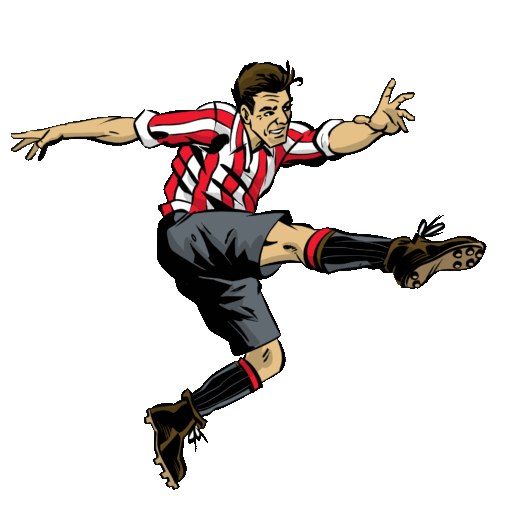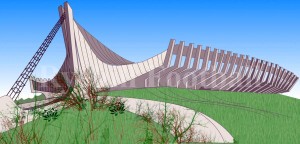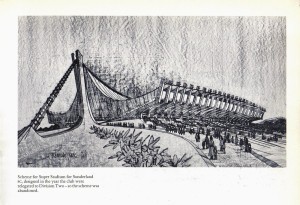It was 2008 when researching about the stadiums that Sunderland have had as homes that I came across a story that I knew absolutely nothing about. It was born out of the following image that I was passed.
I immediately set about trying to trace the architect involved in what was to be a planned new super stadium and managed to track down the man himself; Owen Luder. This is the story of the Sunderland AFC stadium that never was as told by Luder himself:
Notes on the 1970 Project for a Sunderland Super Stadium.
In 1970 my partnership had an office in Newcastle as we had a considerable architectural work in the North East. The “Get Carter” Car park in the Trinity Square shopping centre had been completed some years earlier and the Wickham “Rocket” tower block was in detail design stage in a mainly low rise council housing development of which the Rocket tower (the shape is as it sits on a circular concrete “cassion” foundation – the only way a tall building could be supported on land riddled with the tunnels etc. from Victorian drift and deep mining.
I was approached by Sunderland FC a First Division soccer club to advise on what to do with Roker Park. Apart from the poor quality of the facilities in the ground for spectators (very common with most first division clubs before the Hillsborough disaster) there were increasing doubts on the safety of the main stand. I was told although I do not know and did not question the truth of the statement that the Sunderland Council Borough Engineer who had responsibility for building safety was an avid Sunderland fan and was very reluctant to condemn the stand as unsafe as he would create severe financial and supporter problems for the club.
I was advised there was a tentative proposal for land along side the ground to be sold to a supermarket which it was hoped would provide the money to finance whatever repairs were required for the stand and perhaps improve other supper facilities.
My original brief was to advise on the condition of the main stand and ground generally and the viability of selling off land for a supermarket development. The Sunderland Board was aware that I was an avid Arsenal supporter but that quite properly was not seen as an issue.
As background I had been writing and speaking in the media on the unacceptably poor quality of accommodation and facilities at top soccer club grounds, the track record of accidents resulting in deaths and injuries to suppers, and the economic lunacy of clubs owning dilapidated stadia eating their heads off in running costs and only used probably for about thirty home games each year.
My initial report confirmed that resolving the problems with the main stand would be very costly, maybe virtual rebuilding. Other parts of the ground also needed upgrading to bring them up to reasonable standards of comfort for supporters.
My report indicated that I had doubts whether selling off land alongside for a supermarket would produce enough money to pay for all that was needed.
I then went on to explore the validity of the club being sited at Roker Park. Historically it had been built alongside the docks, shipyards and industry where the majority of the traditional supporters worked and most would have lived nearby. The factory whistle would go at 12.30 on a Saturday; many of the workers would go the nearby pub for a pint and a pie and then to the ground for a 3pm kick off (2.15 in the depths of winter before floodlights).
By 1970 much of the industry, close to the ground – many of the supporters by then worked and lived considerable distances from Roker Park. Saturday morning working no longer applied to them and the logic of a club with 30,000 to 40,000 supporters travelling in to the docks area for football could be questioned. By 1970 accessibility and ease of travel were becoming increasingly important factors in shopping habits and in following football.
I emphasised that increasingly top football clubs would only stay at the top if they drastically improved stadia accessibility and facilities, and found ways to make money out of their stadia apart from the alternate Saturday afternoon home games.
This was a theme I had been writing and speaking about public ally for some time (and continued over the following years until the aftermath of the Hillsborough Disaster created the dramatic social, economic and political climate that enabled the explosion of new stadia in the 1990’s.
I had also been criticising official planning policies that discouraged clubs in the same towns and cities to share grounds, which would double the profitable use and provide funds to build new stadia to acceptable modern standards. Chelsea and Fulham, the two Nottingham and Bradford clubs were classic examples.
Also the reluctance of city and town councils to providing financial support and indeed owning new or improved stadia recognising the benefit to a town of a successful top level football club.
Ground sharing and council ownership of football stadia in Europe and elsewhere was common and very successful.
My advice to Sunderland was that they should explore the possibility of recreating Roker Park in an area closer to and more accessible to where their supporters now lived and worked, build a stadium for multi use – so it earned its keep if possible seven days a week and 50 weeks in a year, and explore the possibilities of ground sharing.
I was instructed to explore these possibilities and produce firm proposals and a scheme that could be considered by the Board.
I investigated various possible sites for a new super stadium.
The one chosen was on the edge of Washington New Town on the motorway with fast road links to Sunderland and to the South and North.
The scheme produced was for a futuristic enclosed multi purpose stadium for 35,000 supporters (mostly seated) on the chosen site with motorway access, massive car parking and modern facilities.
I emphasised the financial advantages of the ground being shared and suggested that Newcastle was the obvious choice as they had only a short lease on their St. James Park ground which needed extensive renovation. My stadia design included the ability to temporarily remove some seating to boost the accommodation to 45,000 for local derby’s. I understand Newcastle was not prepared to even enter a room to discuss the possibility.
The perspective drawing I prepared was included in the 1975 Royal Academy Summer Exhibition and the architectural magazine “Building Design” recently reproduced this as an archive item from that year.
Sadly as far as I am aware no other drawings of the scheme exist unless they are in the Sunderland FC archives. I sold out of my architectural practice in 1987 and in any event a large part of the archives of my work in the 1960’s and 70’s was destroyed in a fire in the building where they were stored in the late 1970’s.
As a footnote Sunderland played Arsenal at Highbury on February 28th. 1970. The Chairman invited me to have lunch at the Great Northern Hotel (by Kings Cross Station) and then travel in the team coach to Highbury.
I had the unusual experience for an Arsenal fan of coming off the visiting teams coach at the main entrance to the marbled halls, and sitting in the Directors Box with the visiting team’s directors. At the end of the match in the Directors dining room after Hill Wood the Arsenal chairman came over to me and commiserated on my teams defeat. I did not have the heart to tell him I was an Arsenal fan, season ticket and shareholder.
Sunderland was sadly relegated that season and that prevented my proposals from progressing further. Subsequently Sunderland did move from Roker Park and built the Stadium of Light. Good but not as adventurous as my proposals.
Having said that my scheme was 10 or 20 years ahead of time. In 1990 following the Hillsborough disaster, politically with tax incentives, TV money and the social pressures for safe stadia the climate was created for a massive investment in new stadia and in many clubs moving to new more accessible locations that their traditional locations with the quality of accommodation and facilities that were then increasingly demanded by the public .
I continued my campaigning for improved soccer stadia. I wrote may articles and gave interviews on radio and TV (I have recorded of most) and won the Publisher 1987 Business columnist of the Year for my article on the Bradford Fire. I organised and Chaired two major seminars at the RIBA on “Sports Stadia Design after Hillsborough” in early 1990 which set the stage for the revolution in stadia design and the building of new stadia in many parts of the country.
In 1996 as President of the RIBA I awarded the Presidents Building of the Year Award to the new Huddersfield Stadium and acted as the architect judge for a number of stadia design awards.
Owen Luder CBE PPRIBA.
So there you have it, the story of the Sunderland AFC stadium that never was. Whats interesting to contemplate is that if Sunderland AFC had retained their position in the top flight we might all have been sitting in this stadium every home game for the past 40 plus years.







